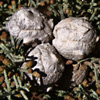Cupressus arizonica, the Arizona Cypress, is the only species of cypress native to the southwest of North America, in the United States. In the wild, the species is often found in small, scattered populations, in canyon riparian associations of mixed-broadleaf plant communities or mixed with other conifers. Several sub-species are recognized in its native range. The largest trees are seldom more than 700 years old.
It is a medium-sized evergreen tree that grows to heights of 10-25 m, and its trunk diameter reaches 0.5 m. The short, stout horizontal branches form a dense, conical or narrowly pyramidal crown, which may sometimes be broad and flat. In young trees, the bark breaks into thin, large, irregular scales. On older trunks and branches the bark is longitudinally furrowed. The leaves are scale-like 2-5 mm long, and grayish-green, bluish-green, or silvery, arranged opposite in pairs and tightly clasping the cord-like or four-sided twigs; they emit a fetid odor when crushed.
The male cones are 3-5 mm long g release pollen in the spring. The seed cones are globular to oblong, 15-33 mm long, with 6 or 8 (rarely 4 or 10) scales, green at first, maturing gray or gray-brown about 20–24 months after pollination. The cones remain closed for many years, only opening after the parent tree is killed in a wildfire, thereby allowing the seeds to colonize the bare ground exposed by the fire.
Arizona cypress grows in dry, well-drained soils on cool sites where the mean annual precipitation is approximately 400-600 mm at elevations from 900 to 2,400 m on gravelly slopes or cuts with northern exposure. Arizona cypress seedlings are shade intolerant and survive best in full sunlight on bare mineral soils. It is regarded as an intolerant species that requires disturbance to expose mineral soils for seedling establishment. Even low-intensity surface fires are lethal to Arizona cypress with stem diameters less than 10 cm. Larger trees are also not very resistant to fire. The serotinous cones of Arizona cypress persist on the tree for years. When opened by the heat of a fire, the seeds fall on the exposed mineral soil, producing thickets of seedlings.
Arizona cypress is valued as an ornamental. It is also planted for windbreaks. Direct seeding is slightly better than transplanting for successful establishment.
The wood of Arizona cypress is light, moderately soft, close-grained, durable when seasoned properly.
Written by Amram Eshel






